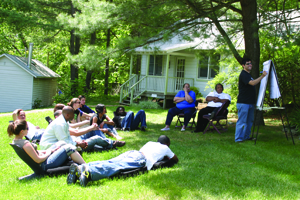The 25 staff members at Young Community Developers (YCD) drove about an hour and a half away from the organization’s San Francisco headquarters for an employee retreat in 2013. When they returned they had a new program.
YCD provides education opportunities and career training to low-income youth and adults in the Bay area. At the retreat, “We take staff through what we as the leadership team do,” said Deputy Director Dion-Jay Brookter. One of the activities during the retreat that year was asking staff: “If you had $100,000 for the organization, what would you do with it?” One employee came up with the idea of starting a solar training program. The organization developed a plan and wrote grants to implement the program. YCD now trains clients how to install photovoltaic panels.
Employee retreats can be an opportunity to breathe new life into operations and build team cohesion. They can provide staff with much-needed rest and relaxation. They can be both. And, they don’t have to break the bank. Despite the development of the new program and other business matters, such as revamping the mission and vision statements, YCD’s retreat is more about “cohesion,” said Brookter. “I think it’s played an integral part in our work because it shows our staff that we value you, we understand that you need to decompress,” he said. They’ll do that via a group hike or jog, he said. One year they did a scavenger hunt.
There’s downtime built in through group meals and evening relaxation. “We understand that you’re working extremely hard. You’re going after jobs, you’re listening to other people’s issues, but we want to make sure we give you time for you. It can get to you,” Brookter said. In contrast to YCD’s team-building retreat, The Mission Continues, based in St. Louis, Mo., has more of a working retreat. The team gathers to discuss business items such as goals and progress. There are some team-building elements, though. “We’ve noticed this became important as we went regional,” said Laura L’Esperance, senior vice president of brand and communications. “As we opened up offices around the country, it becomes important to be on the same page, see each other and interact on a personal level, and also have some fun.”
Most employees of The Mission Continues were until recently based in St. Louis, along with a few in New York City, said L’Esperance. St. Louis still has the largest concentration of staffers, but the organization now has “more people outside St. Louis than in it,” according to L’Esperance. The retreat has always been in St. Louis, but the next retreat will take place in Nashville. “Part of it is ensuring downtime,” said L’Esperance. “A lot of local people have long commutes and busy lives, so it’s hard for them to stay fully engaged” in a retreat where they have to drive home at the end of the night. “The commitment we made was we’d always go to a city that’s easy for everyone to get to and where our program participants are,” she said.
The Mission Continues usually does two retreats per year, but as the organization grows that might not be possible, said L’Esperance. The retreat is an opportunity for the organization as a whole to focus on strategic goals. “We set out a number of goals, themes, targets about where we want programs to go, skills we need, what our teams will look like. These are two opportunities per year to check in with everyone,” she said. The retreat usually kicks off with some morning physical training. As a veterans services organization, “We haven’t gotten that far away from our military roots,” said L’Esperance. Then the whole organization gets together to tackle agenda items. Past events have revolved around new programs, new partnerships, and a revamp of the mission statement.
Next, staff is broken up into small groups. The groups could be based on region or based on function. “At the end, we’ve had someone from each team describe the five commitments they’ll make,” said L’Esperance. One year the communications team committed to starting an internal newsletter. Other teams have said, “We’re going to commit to x-number of blogs around internal issues per week, or improving the website,” she said. “Each team gets up and makes commitments.” Then, at various points in the year they are followed up.” If you work for DonorsChoose.org, you might go on a retreat to share your team’s goals and victories with the rest of the organization and to learn more about reading financial statement.
At the same retreat, you might also be tasked with getting a cookie on your forehead into your mouth without using your hands. “We spend about half the time catching up with the teams and what they hope to achieve. The other half is social and professional development activity,” said Melanie Duppins, senior director of policy and human capital.
DonorsChoose shifted the retreat from New York City in 2014, where the organization is based, to a location about two-and-a-half hours away in Connecticut. “Unlike other organizations where maybe a retreat’s primary purpose is either content delivery or relationship building, ours really does have that dual purpose,” said Duppins. “We found we’re not being served properly by having a one-day retreat in New York City.
It was not providing enough relationship building and not enough creativity.” The retreat takes place in July, soon after the July 1 start of the new fiscal year. This is deliberate, said Duppins. It helps set the stage for the coming year. “You cut over to a new fiscal year and other than the back-end finance change, it can be easy to bleed into the next fiscal year without celebrating what went well and looking to the future,” she said. “We can’t risk that. We have to be calibrated because our goals are aggressive.”
Pathway Homes of Fairfax, Va., opts to get employees away from their desks for brief portions at various points in the year. The organization has a staff fun day, a team-building day, a staff recognition event and a holiday party. These events are all a “conscious decision for leadership to say, we value you, this is a chance to step outside the daily grind,” said COO Eleanor Vincent. She said mini-retreats are integral in staff connecting with each other.
The breakneck pace of their work often does not often allow employees to slow down and chat. While everyone is passionate about the organization’s mission, “the work culture is not one where people go out to lunch together,” said Vincent. “People tend to work through lunch or grab a sandwich on the way to a client meeting. We’re a team-oriented organization, and we’re building that sense of family. Those events seem to be more impactful for us, as opposed to the more business-type.”
Duppins said DonorsChoose budgets about $500 per employee, of which there are currently 75. YCD’s retreat comes in at roughly the same figure; Brookter estimated between $2,500 to $3,500, depending on where and when the event is held. Vincent said the cost of Pathway Homes’ different events varies but she has a budget of about $2,500 for the staff recognition event. The Mission Continues keeps costs down by going to where the organization’s partner Southwest Airlines flies. She said staffers share rooms and the organization usually uses a hotel for meetings. The cost is “not nothing, but it’s not like we’re going to the Greenbriar,” she said.
The cost actually is nothing for attendees of the Omega Institute for Holistic Studies’ Service Week. The Rhinebeck, N.Y., nonprofit facility opens its doors to nearly three dozen nonprofits for a week each year, broken up into a pair of three-day retreats. “It’s not only this working retreat, which has all the benefits like building relationships and increasing organizational clarity, but we offer a unique” rural setting at the 200-acre site, said Community Engagement Manager Susan Grove. Participants “have this real opportunity to retreat in the midst of working together.
In addition to that ability to focus on organizational and individual wellness, on each half there are 15 or 16 other organizations participating, so there’s opportunities to make connections and inspire each other. There’s a whole community aspect,” she said. The Omega Institute has an online application for Service Week. The only requirement is that applicants must be 501(c)(3) organizations. Still, it is competitive; the facility received about 80 applications for 33 spots at Service Week 2015, according to Grove. Agendas during Service Week are partially self-directed and partially set by participants. Grove said the Omega-led portions include opening and closing sessions and a consultation with the New York Council of Nonprofits.
On the second and third days, organizations have a degree of latitude to set their own agendas. “It’s a hybrid between organizations structuring their own time and things from our experience we’ve learned are helpful,” said Grove. Whatever its focus, a staff retreat is an opportunity to take a deep breath and remember what’s important. “It really helps us. It allows us to buy into concepts and mission and vision,” said Brookter. “It’s something I recommend for anyone who might not currently have a staff retreat.” NPT











